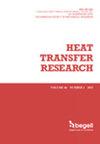利用具有纳米增强冷却功能的波纹通道实现锂离子电池组的热管理
IF 1.6
4区 工程技术
Q3 THERMODYNAMICS
引用次数: 0
摘要
在这项研究中,使用波纹冷却通道和 Al2O3-Cu/water 混合纳米流体的冷却系统被用作棱柱形锂离子电池的电池热管理系统 (BTMS)。基于有限元方法建立的计算模型在不同雷诺数下使用固体体积分数从 0% 到 2% 不等的混合纳米流体。冷板呈波纹状,在棱柱形锂离子电池单元之间有各种方形凹槽。随着固体纳米粒子体积分数和波纹冷却通道数量的增加,最高温度也随之降低。在比较冷却通道数量最少和最多的情况下,发现使用水时最高温度降低了 3.07 K,而使用 Al2O3-Cu/ 水混合纳米流体时(固体体积分数最大时)最高温度降低了 1.86 K。在使用固体体积分数最高的纳米流体时,冷却通道中的方形凹槽数量对温度下降没有显著影响。本文章由计算机程序翻译,如有差异,请以英文原文为准。
THERMAL MANAGEMENT OF LITHIUM-ION BATTERY PACKS BY USING CORRUGATED CHANNELS WITH NANO-ENHANCED COOLING
In this study, a cooling system using corrugated cooling channels and Al2O3−Cu/water hybrid nanofluid is offered as the battery thermal management system (BTMS) for prismatic Li-ion batteries. A computational model built based on the finite element approach uses hybrid nanofluid at solid volume fractions ranging from 0 to 2% at various Reynolds numbers. The cold plates are corrugated and have a variety of square grooves positioned between prismatic Li-ion battery cells. The maximum temperature decreases as the volume fraction of solid nanoparticles and the number of corrugated cooling channels increases. When cases of using lowest and highest number of cooling channels are compared, maximum temperature reduction is found as 3.07 K when using water and 1.86 K when using Al2O3−Cu/water hybrid nanofluid (at the largest solid volume fraction). The number of square grooves in the cooling channels does not have any significant impact on the temperature drop when using nanofluid at the highest solid volume fraction.
求助全文
通过发布文献求助,成功后即可免费获取论文全文。
去求助
来源期刊

Heat Transfer Research
工程技术-热力学
CiteScore
3.10
自引率
23.50%
发文量
102
审稿时长
13.2 months
期刊介绍:
Heat Transfer Research (ISSN1064-2285) presents archived theoretical, applied, and experimental papers selected globally. Selected papers from technical conference proceedings and academic laboratory reports are also published. Papers are selected and reviewed by a group of expert associate editors, guided by a distinguished advisory board, and represent the best of current work in the field. Heat Transfer Research is published under an exclusive license to Begell House, Inc., in full compliance with the International Copyright Convention. Subjects covered in Heat Transfer Research encompass the entire field of heat transfer and relevant areas of fluid dynamics, including conduction, convection and radiation, phase change phenomena including boiling and solidification, heat exchanger design and testing, heat transfer in nuclear reactors, mass transfer, geothermal heat recovery, multi-scale heat transfer, heat and mass transfer in alternative energy systems, and thermophysical properties of materials.
 求助内容:
求助内容: 应助结果提醒方式:
应助结果提醒方式:


